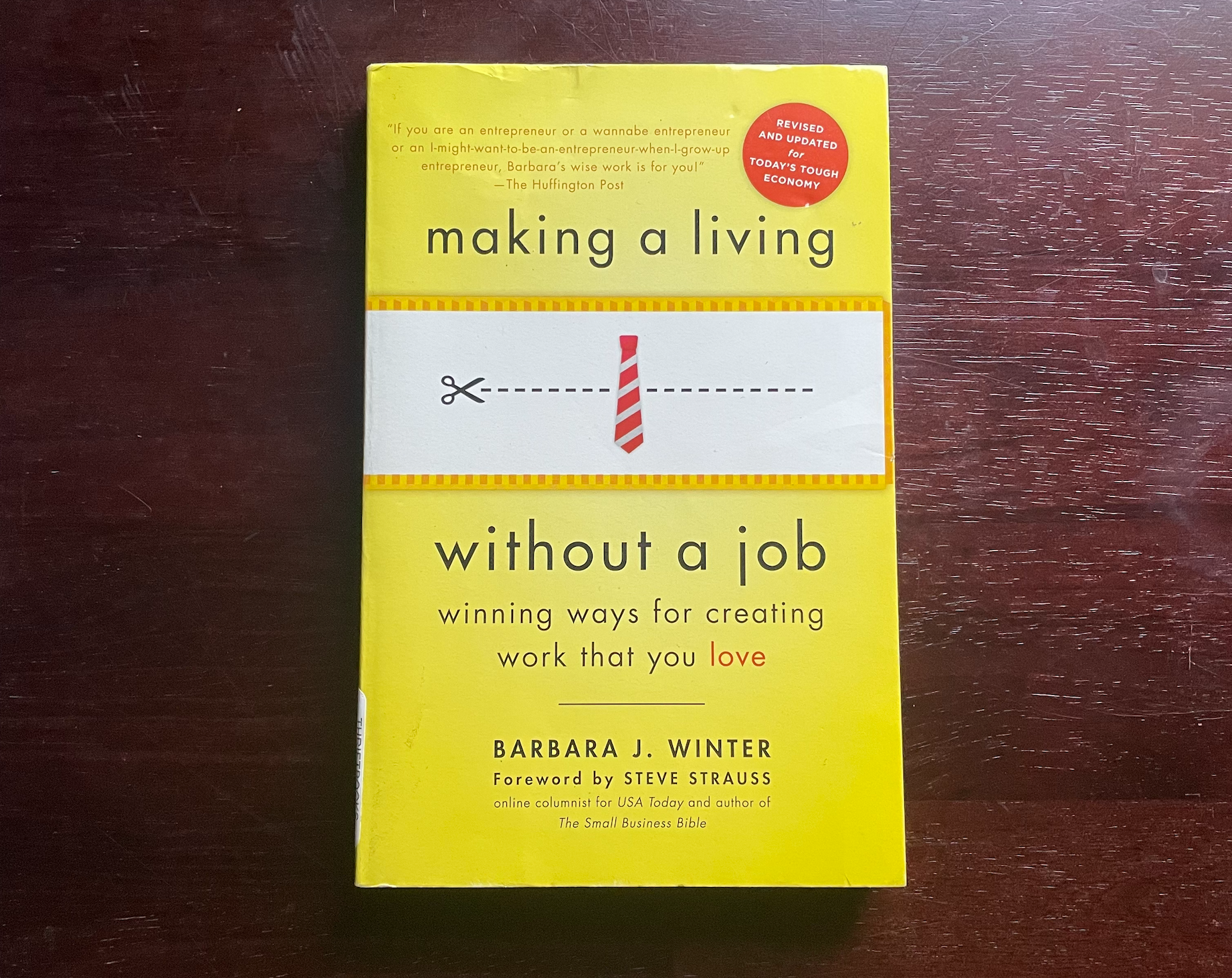Barbara J. Winter’s Making a Living Without a Job: Winning Ways for Creating Work That You Love is an essential read for anyone thinking of pursuing a path of entrepreneurship and self-employment.
In this post, I am reviewing Living Without a Job, sharing the main concepts I took away from the book and other important insights you might find helpful if you’re looking to create more meaningful and fulfilling work. At the end of the review, I rate Living Without a Job and include a link to purchase the book.
A Brief Synopsis of Living Without a Job
The title of Barbara J. Winter’s masterpiece could not be any more accurate. In Making a Living Without a Job, she shares with readers a concrete path to creating work they love—work that goes beyond a good salary and great benefits.
The type of work Winter urges us to create is work that moves us and is our own. It’s not just about being a business owner or entrepreneur for Winter. Rather, she wants us to “honor [our] creativity, add meaning and purpose to [our] lives, and allow [us] to go as far as [our] imaginations will permit” (Winter, 2009, p. xv). Most importantly, through exercises, poignant questions, and actionable tips, she shows us exactly how to get there.
“How could we have gotten it so wrong all this time, thinking that money was adequate compensation for doing work that we loathed—or, at least, cared little about? What if we began to expect from our work high levels of satisfaction? What if we refused to have less than that? And what if we believed that our work was one part of a grander goal?”
— Making a Living Without a job (Winter, 2009, p. 18)
The book is split up into several sections. The first few parts is more reflective and personal in nature, because Winter wants us to understand ourselves much more so that we can be certain the work we are seeking actually suits us.
The subsequent sections guide us in how to brainstorm viable options for our success. The last few sections are framed around already knowing what your business will be and making sure it is sustainable.
Self Awareness
Self-Discovery leads to Self-Esteem leads to Self-Employment leads to Self-Discovery leads to Self-Esteem
Making a Living Without a job (Winter, 2009, p. 37)
One thing that immediately stuck out to me when reading Making a Living Without a Job is just how much of a personal development book it is. Surely, most of it focuses on creating and growing businesses, but in the first half in particular, Winter spends a lot of pages writing about the importance of self-awareness.
Readers soon realize that having a business around work that you love is intricately tied to high self-awareness. The way Winter sees it, we need to to know what we love and find meaningful, what drives us and gives us energy, and create a business around that.
For these reasons, you will find that you are asking yourself powerful questions throughout the beginning of the book. Most of these questions will be related to what you really want out of life, which will lead you to creating work around that.
“[The joyfully jobless] see our business as a natural extension of who we are and what we love to do. We have spent time and energy exploring and understanding ourselves so that we could find ways to earn a living by being ourselves”
— Making a living without a job (Winter, 2009, p. xvi)
What I appreciate most about her take on self-awareness, though, is how she encourages readers to create the person they want to be. She shares that while there is some discovery to be taken—as far as what you used to enjoy as a kid and what you would do absent the constraints of bills and other responsibilities—the self-awareness process is not about finding the lost person within you.
Instead, it’s about reflecting deeply and creating the person you want to be, and the life you want to lead. Once you have a better understanding of these two things, you can then begin thinking of ideas for work to get you closer to both.
The Joyfully Jobless
The main premise of this book is how to eventually become “joyfully jobless”. This is Winter’s phrase for people who have their own successful business that energizes them and suits their needs and desires.
She shares how she was not always joyfully jobless, nor did she have any clue that this was a viable option. Like many of us, Winter grew up with similar ideas about work–get a job at a big corporation, one with good benefits, and stay there until you retire.
“With every person who chooses this path, it gets a little bit easier for all of us. As more of us strike out on our own, we find that we have to defend our choices far less often”
— Making a Living Without a job (Winter, 2009, p. xv)
I think a big part of why her message is so effective is because she’s shares so openly about her own journey. I felt a connection to Winter, like she understood all the questions I’ve been asking about the meaning of work and traditional paths.
If you’re someone who is thinking there must be more to your work life, and life in general, I think you’ll resonate with being joyfully jobless.
But, you’ll need to know where you’re going, first. And then, like all good things in life, you’ll need to put in some work to get there.
Let’s start with where you’re heading.
Having a Vision
A key point from Making a Living Without a Job is the importance of having a vision for what you actually want. Self-awareness is without question the first step in this process. But eventually, you’ll need to have a sense of where you’re going so you can put the necessary pieces in motion to get there.
This sounds straightforward, I know. Yet as Winter shows us, it’s surprising how many people don’t do this. And when they do, their vision might be extremely limited, given the messages they’ve received about what’s possible.
I’m, no doubt, guilty of this. Prior to just a year ago, I was convinced you had to have one or the other: a highly lucrative job or business, or work you loved. Now I know these two things are far from being mutually exclusive. And more importantly, I can now envision (and work toward) a life where I’m financially free and love the work I do.
Winter gives us several tools to create our life vision without constraints. One of which is an exercise where she urges us to think about what we want out of life with as much detail as possible. A few examples are what kind of community we want to live in and the countless (very) specific aspects of that community, in addition to the types of activities we want to engage in and how frequently.
By intentionally formulating this mental picture at the start of her journey, Winter realized her vision “was quite unlike [her] actual life in Colorado” (Winter, 2009, p. 44). It was in this moment when she realized she needed to make a change.
If your goal is to become joyfully jobless, you might find you need to do the same.
Taking Action
“You may have to change your thinking and challenge your self-imposed limitations. I promise you, however, that you do have the equipment you need for becoming joyfully jobless. the only question remaining is this: Do you have the desire?”
— making a living without a job (Winter, 2009, p. 17)
This book is not one you just read passively and try to absorb. On page after page, Winter calls readers to action and challenges us with reflective exercises meant to help us adopt an entrepreneur’s mindset.
As she warns us, the answers aren’t always easy nor comfortable. But this is precisely the point. Take the following questions, for example: “Have I followed my dreams? Lived as I wanted? Exercised my own creative spirit? Lived my values? Built something of my own? Made my children proud? Thought my own thoughts? Acted with courage and magnificence?” (p. 19)
When I first read this and thought about my answers, it didn’t feel that great. I’m starting to follow my dreams more without fear of what others will think, but I’ve spent a lot of time trying to achieve a version of success defined by society and my family. As a result, I’m only now beginning to think about what my true values are and the steps I need to take to life a live that’s predicated on those values.
That said, this is why reading books like Making a Living Without a Job are important–they stretch are thinking in ways we cannot imagine.
High-Yield Advice/Tips for Success
As I’ve already written, there’s a lot packed into Making a Living Without a Job. This post would thus be very long if I outlined each of the high-yield pieces of advice and tips that Winter provides readers.
That said, below I have included some of the most powerful exercises, pieces of advice, and tips:
- The $100 Hour
- Dedicate one hour daily to intensely focus on thinking about ideas that can bring you $100. Winter’s thinking here is that we often get so caught up in trying to think of these massive business ideas that will make us millions. Starting small, in contrast, helps us get the ball rolling while simultaneously developing our creativity that can lead to bigger and bigger ideas. Don’t worry about actually making the $100 in the hour, just get started on it after you already have some ideas.
- Don’t doubt your creativity
- Winter reminds readers that many of us have been led to believe that creativity is a gift that certain people are blessed with. She tells us this could not be further from the truth. Your creativity–which plays a huge role in you being able to start and maintain a successful beusiness–can be cultivated intentionally. One simple way is to trust in your own creativity and consistently repeat affirmations like, “There are an unlimited number of excellent ideas in my subconscious mind right now” (Winter, 2009, p. 177).
- Find the essence of your ideal work
- What Winter means by finding the essence of your ideal work is to think about the specific feelings it will produce, as well as the intabgible rewards and satisfactions you’ll receive from doing the work. “When you know the essence of what you want, you realize it can come in many ways–opening your options and alternatives” (Winter, p. 56)
Conclusion
Though the last edition of Making a Living Without a Job was published in 2009, there is a wealth of relevant information in the books for folks at all different stages of their business journeys. Still, given just how much has changed over the last 10 or so years, there are some insights that are less suitable to the current moment in time.
That said, I would still highly recommend this book for anyone thinking that working in a traditional job might not be their path. The book is very well-written and extraordinarily actionable. Lastly, Making a Living Without a Job is powerful because it gives us role models–people who’ve embarked on untraditional paths and have been wildly successful (and happy) in the process. This is one of the books I see myself returning to in the near future, for sure.
‘Till Next Time, Travel Friends!
Rating: 8/10







